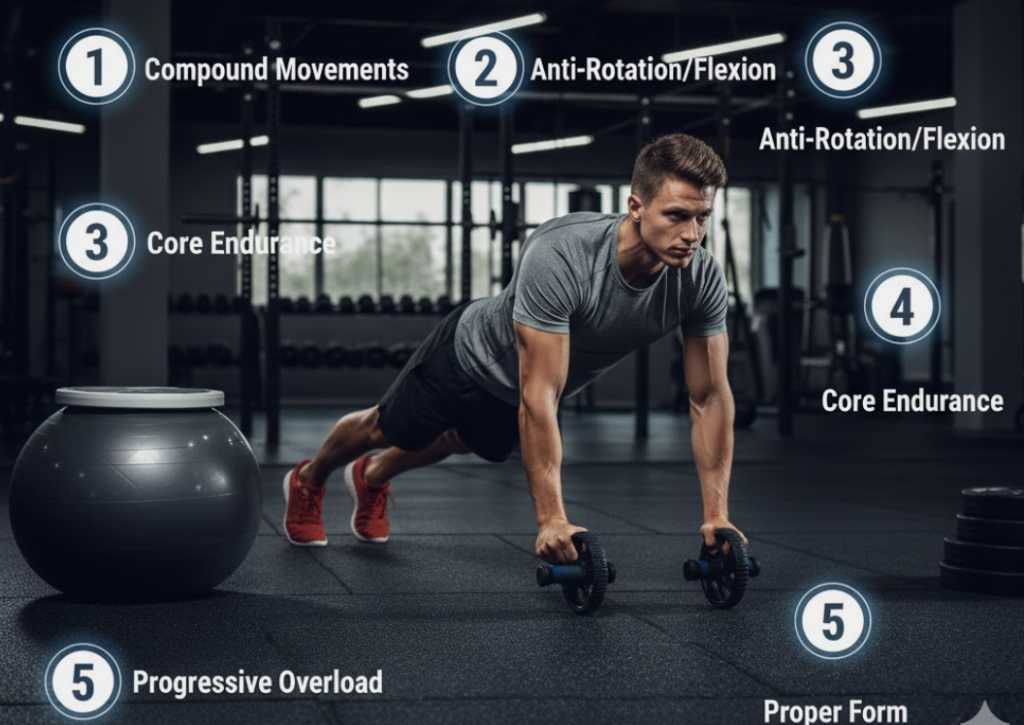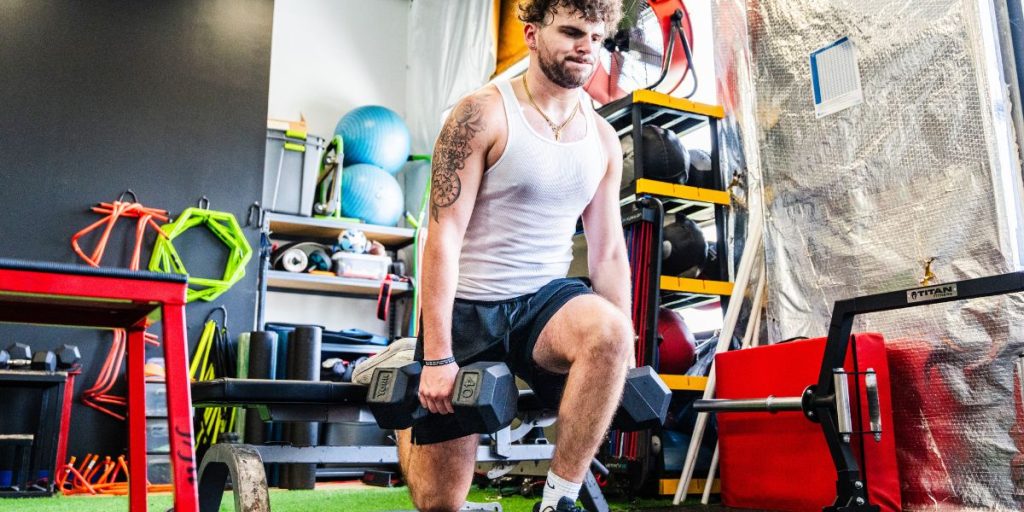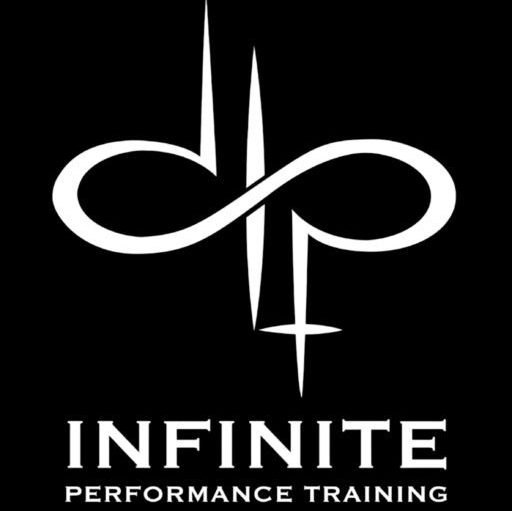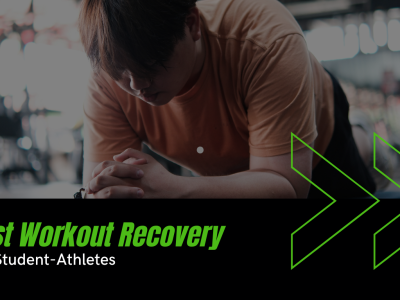Do you want to learn about the best core exercises for athletes?
Watch any elite athlete move, and you’ll see one thing they all share: a rock-solid core. It’s what lets a pitcher twist with control, a sprinter explode off the line, and a basketball player change direction without losing speed. Core strength training fuels every skill that wins games.
Stick around as the team here at Infinite Performance Training uncovers the exercises that turn your midsection into the ultimate source of power and stability.
Top 5 Core Training Keys for Athletic Power and Stability
1. Train the Core to Resist, Not Just Flex.
Your core’s real job isn’t endless crunches—it’s resisting unwanted movement. Anti-rotation (Pallof press), anti-extension (dead bug), and lateral stability work (side planks, suitcase carries) create a strong, stable center that protects the spine and transfers force efficiently.
2. Build Power Through Controlled Rotation.
Most sports live in the transverse plane—rotating, twisting, and stopping with precision. Medicine-ball throws, landmine presses, and cable chops teach athletes to load and release energy safely while improving speed and balance through the hips and trunk.
3. Prioritize Stability Before Strength.
Planks, carries, and crawling patterns teach control and breathing under tension—crucial for sprinting, cutting, and jumping. A stable torso keeps energy flowing from your legs to your arms without leaks, giving every move more purpose and control.
4. Core Strength Prevents Injury.
A strong, stable midsection keeps the pelvis and ribs aligned, reducing stress on the knees, hips, and lower back. That alignment protects against non-contact injuries by improving how the body absorbs and redirects force during high-speed movements.
5. Integrate, Don’t Isolate.
The best athletes train their core within full-body movement—front squats, deadlifts, and farmer carries build stability through load. Mix these with rotational and anti-rotation drills 3–4 times a week for a balanced, sport-ready foundation.
What Are the Most Effective Core Strength Exercises for Athletes?

The core is more than abs. It is the link that transfers force between the lower body and upper body. Train it to resist collapse, to steer rotation, and to transmit power cleanly. That mix builds stability for contact and speed for open space.
Here is how to target the full system with purpose:
- Anti-extension work (resist low-back arching): Dead bug, ab wheel, stability-ball rollout. Start with 3 sets of 6 to 10 controlled reps.
- Anti-rotation work (stop unwanted twist): Pallof press, cable anti-rotation hold, offset farmer carry. Hold 20 to 30 seconds per side for 3 to 4 rounds.
- Lateral stability (frontal plane control): Side plank with top-leg raise, suitcase carry. Work 20 to 40 seconds per side for 3 sets.
- Hip-to-rib integration (bracing under motion): Kettlebell front rack carry and crawling patterns. Walk 20 to 40 meters per set.
- Rotational power (when sport demands it): Medicine-ball scoop throw and shot-put throw. Perform 4 to 6 sets of 3 reps with full intent.
Coaching focus: keep ribs stacked over hips, breathe through the nose when possible, and brace before you move. Quality reps beat long sets.
GET IN TOUCH
Schedule a Training Session
Which Core Workouts Build Maximum Athletic Power?
Power shows up when a stable torso lets the hips and shoulders fire without leaks. The goal is crisp acceleration with clean deceleration so the body can load, release, and stop safely.
Here is a power block that pairs well after a dynamic warm-up:
- Medicine-ball scoop throws to wall: 4 sets of 3 per side. Rest 60 to 90 seconds. Aim for hip drive and a tall finish.
- Medicine-ball shot-put throws: 4 sets of 3 per side. Step through the throw to teach force transfer.
- Kettlebell swing (hip hinge power): 5 sets of 8. Stop each set before form fades.
- Landmine rotational press: 3 sets of 5 per side. Pivot the feet, brace the midsection, and finish tall.
How Do Planks and Variations Enhance Core Stability?
Planks teach the body to create stiffness that protects the spine while limbs move. That stiffness sets the stage for safe force transfer during sprints, cuts, and lifts.
Try this simple progression for stable, sport-ready bracing:
- Front plank with breathing: 3 sets of 20 to 30 seconds. Exhale to set the ribs, then maintain quiet nasal breaths.
- Side plank with row: 3 sets of 6 to 8 rows per side. Keep hips level as the arm moves.
- Stir-the-pot on ball: 3 sets of 8 to 12 circles each way. Move the shoulders, not the low back.
- RKC plank (short, high-tension): 4 sets of 10 to 15 seconds. Squeeze glutes and lats to lock the torso.
Key cue: if you feel your low back, reset your position or shorten the set.
What Role Do Rotational Core Exercises Play in Sports Performance?
Most sports live in the transverse plane. A good core lets you wind up, release, and stop without wasting energy. Rotation work trains three skills: load the spring, fire the hips and shoulders together, then brake under control.
Use this rotation and anti-rotation mix to improve transfer and control:
- Standing cable rotation (hip-led): 3 sets of 5 per side. Start from the hips, then let the torso follow.
- Step-behind medicine-ball throw: 4 sets of 3 per side. Teach rhythm, not just effort.
- Pallof press hold: 3 sets of 20 to 30 seconds per side. Resist twist to protect the spine during cuts.
- Half-kneeling chop and lift: 3 sets of 6 per side. Lock the pelvis while the shoulders travel.
Rule of thumb: speed on the throw, control on the brake. If you cannot stop the motion cleanly, lighten the load.
How Can Core Stability Exercises Improve Athletic Performance?
A strong core isn’t just about looking fit, it’s moving better. Every sprint, jump, or swing starts with the spine, hips, and trunk working together. When your core is stable, energy travels efficiently from your lower body to your upper body without “leaking” through weak links. That means faster acceleration, smoother direction changes, and cleaner technique.
In biomechanics terms, core stability increases force transfer efficiency. For instance, a baseball player with strong rotational control can hit harder without extra arm strain. A sprinter with a stable pelvis keeps stride alignment tight, avoiding wasted energy. The result? Better power, balance, and endurance across every sport.
Why Is Core Stability Crucial for Injury Prevention in Athletes?
Most non-contact injuries happen when the body cannot control position at speed. Core stability keeps the pelvis and ribs aligned, which controls how forces hit the hips, knees, and spine. When the trunk sways or rotates at the wrong time, joints down the chain absorb extra load.
Stable athletes share three protective advantages:
- Lower spinal shear: A well-braced torso limits unwanted motion in the lumbar spine during lifts, landings, and contact.
- Better knee control: Trunk stability reduces inward knee collapse on cuts and landings, a common path to soft tissue strain.
- Hamstring and groin protection: A steady pelvis keeps these muscles at safer lengths during rapid swing and change of direction.
5 Best Balance and Stability Drills for Athletes:

Before the list of best balance and stability drills for athletes, a quick guide to get more from every drill: focus on tall posture, quiet feet, and smooth breathing. If the lower back works harder than the abs and glutes, reset your position.
1. Pallof press with split stance
- Why it works: Trains anti-rotation while the lower body manages a narrow base.
- Do it like this: Press cable or band straight out, hold 20 to 30 seconds per side for 3 sets. Hips level, ribs stacked.
2. Single-leg RDL reach
- Why it works: Ties foot stability to hip control and trunk stiffness.
- Do it like this: Light load or bodyweight, 3 sets of 6 to 8 slow reps per side. Keep the pelvis square.
3. Suitcase carry
- Why it works: Lateral anti-flexion control while walking.
- Do it like this: Hold a kettlebell at one side, walk 20 to 40 meters, 3 to 4 trips. Stay tall, do not lean.
4. Side plank with top-leg abduction
- Why it works: Links the lateral core to the hip abductors for frontal plane control.
- Do it like this: 3 sets of 15 to 25 seconds per side. Hips forward, neck long.
5. Half-kneeling chop and lift
- Why it works: Trains diagonal force paths used in throws and cuts.
- Do it like this: Cable or band, 3 sets of 6 to 8 smooth reps per pattern. Pelvis locked, motion through the shoulders and upper back.
How Does Core Stability Support Functional Movement Patterns?

The ability to stabilize the trunk keeps power flowing efficiently through the body while protecting the spine and joints. When core stability is weak, energy leaks occur, forcing smaller muscles to overcompensate and raising injury risk. A steady core ensures your body moves as one solid, coordinated unit, improving rhythm, control, and total-body performance.
Here’s how core stability connects to each major movement pattern:
| Functional Movement Pattern | Core Stability Function | Athletic Benefit | Coaching Tip |
|---|---|---|---|
| Squat / Hinge | Bracing through the abdomen and obliques prevents lumbar rounding and keeps the spine neutral under load. | Stronger lifts, better hip drive, and reduced back strain during squats and deadlifts. | Exhale slightly, brace your stomach, and keep ribs aligned over hips before descending. |
| Lunge / Step | Pelvic control stabilizes the hips and keeps knees tracking properly. | Improved balance and power during acceleration or change of direction. | Keep your pelvis square and avoid side tilt when stepping or lunging. |
| Push / Pull | A firm midsection stabilizes the shoulders and thoracic spine, allowing efficient arm movement. | Greater pushing and pulling strength with reduced shoulder stress. | Maintain core tension throughout the movement, especially during eccentric phases. |
| Rotation / Throw | Controlled hip and rib movement allows energy transfer through the torso without over-rotation. | More speed and precision in swinging, throwing, and striking motions. | Load through the hips first, then unwind the torso for explosive yet safe rotation. |
| Carry / Brace | Isometric contraction builds deep endurance in stabilizing muscles and reinforces posture. | Stronger posture and durability under prolonged tension. | Focus on breathing through your diaphragm to sustain tension without stiffness. |
When your core resists unwanted motion, your body can channel more energy into the movement that matters most. That’s the difference between lifting heavy and moving efficiently.
Top Core Conditioning Routines for Athletes?
Every sprint, jump, or deadlift starts with stability through the stomach and hips. Athletes with strong cores move more efficiently, resist fatigue, and lower injury risk. A good routine balances isometric exercise for endurance, dynamic movement for power, and rotation for agility.
Here’s how an effective program looks:
- Day 1: Stability and control (planks, Pallof press, and side bridges). These build endurance and joint alignment.
- Day 2: Dynamic power (medicine-ball slams, rotational throws, plyometrics). These enhance explosive transfer through the torso.
- Day 3: Integration with lifts (front squat, farmer carry, and deadlift). These link the core with total-body strength.
When combined, these sessions support better physical fitness and create a more substantial base for high-performance movement across any sport.
How Often Should Athletes Perform Core Conditioning Routines?
Core training frequency depends on load and sport, but most athletes benefit from 3 to 4 sessions per week. Frequency is key to maintaining both strength and endurance without overtraining.
A practical schedule looks like:
- Two light days: Focus on stability and breathing work.
- One moderate day: Include rotational strength and anti-flexion exercises.
- One integration day: Blend compound lifts and plyometrics to test coordination.
Core training supports overall physical fitness, but its real value lies in complementing the rest of the training plan. Too much intensity can tighten the midsection, affecting movement and breathing efficiency, so balance strength days with mobility or physical therapy sessions.
What Core Training Tips Boost Athletic Performance?
A strong core fuels everything from balance to acceleration. Here’s how to maximize results:
- Train patterns, not parts. Focus on bracing, rotation, and anti-rotation rather than isolated stomach crunches.
- Use the breath. Proper breathing increases intra-abdominal pressure, giving the spine natural support.
- Add tension with purpose. Isometric exercise builds deep core control without overloading joints.
- Pair core and compound lifts. Moves like the deadlift, front squat, and overhead press naturally challenge the core.
- Include movement variety. Combine stability, mobility, and plyometrics to keep adaptations broad.
GET IN TOUCH
Schedule a Training Session
What Are Common Mistakes to Avoid in Core Training?
Even strong athletes make small errors that stall results. The most common issues include:
- Over-reliance on crunches: They work in one direction but miss rotation and stabilization.
- Neglecting posture: Poor alignment turns core training into strain instead of support.
- Skipping isometric holds: Quick reps don’t teach endurance—steady tension does.
- Ignoring breathing mechanics: Holding your breath limits performance and increases stiffness.
- No recovery plan: Core fatigue affects lifts, running, and even balance work; physical therapy input can help with recovery or technique correction.
With proper progressions, balanced movement, and focused breathing, athletes improve health, protect their spines, and build the foundation for high-level physical fitness.
The Final Word on Best Core Exercises:
Do you know why weight builds on the midsection? It is center mass, the middle! It is where your body SHOULD be the strongest, but it isn’t for most, which is why many athletes suffer injuries due to a weak core.
Strong performance starts with a stable center. Train the core to resist, transfer, and control force, then watch speed, power, and durability improve in tandem. If you want a plan that fits your sport and schedule, let’s connect.
Contact the team here at Infinite Performance Training, and we will build a simple, progressive program that turns stability into results.


 7 Post-Workout Recovery Strategies for Athletes to Optimize Performance
7 Post-Workout Recovery Strategies for Athletes to Optimize Performance
Leave a Reply